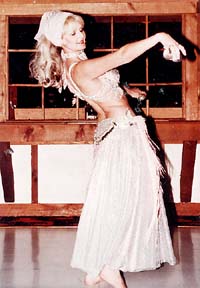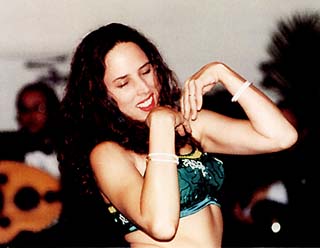The Body Is the Music
The Beginnings
By Barbejoy A. Ponzio, Fri., Aug. 6, 1999
Z-Helene Christopher, Middle Eastern dance instructor for Austin Community College and national touring performance star, is a profound believer in the Goddess worship-origin of her art form of Belly Dance Fusion. "The big Goddess movement going on in the country and the world now is a subgroup of bellydancers," she says. "A lot of us believe that history got it wrong. There was a Great Mother Earth, a Mother Goddess that came about before the Father. The Father came about with having to protect land with war because we needed a powerful, fierce, warring god, whereas the fertile land-giving god was the Mother Earth. There are people who feel passionately the opposite. It is very controversial, and it goes beyond the belly-dance world. I think a lot of the movements, such as the circles, figure eights, spirals, straight lines, you see in the neolithic art world, 9,000 to 4,000 BC. ... You will see a lot of these designs on pottery that deal with fertility, with rhythm, with cycles. In my opinion, this dance is very old. It stems from fertility religions. It is that ancient, primordial quality about this dance that gets people hooked into watching it."
What's in a Name?
|
|
The term belly dance did not originate during ancient times. It was invented by Sol Bloom in 1893. His "Street in Cairo" exhibition at the Chicago World's Fair was not soliciting many patrons. Once he began advertising that there were "belly dancers" inside, people began pouring into his pavilion. Bloom made enough money to finance his later congressional campaign. Unfortunately, his coined phrase, "belly dance," is still around today.
Melissa Amira (Arabic for princess) is one dancer who will not use "belly dance" to define her art. She adamantly quips, "No, I use it to tell people what it isn't. When I tell people I am a dancer, they ask me what I perform. 'I perform Middle Eastern-style dancing.' 'Oh, you are a belly dancer.' 'Yes, for lack of a better term, I suppose that is what you could call me.' From that moment on, the mindset is there. I hate the term. And I have good friends who embrace the term. I hate it because it came out through the exploitation of some very brave and talented women. It is a beautiful art form that is extremely misunderstood as well. I wish I could take every man in America and put him in a beginner bellydance class. Then I think the connotation with stripping would end right there."
Pat Taylor, an art appreciation instructor at Southwest Texas State University who is also a dance scholar and professional Middle Eastern dancer, defines her expression of Middle Eastern Dance as Oriental. "I make a distinction between belly dance and Oriental dance," she says. "Belly dance includes everything from the Renaissance Fair Dancer [to] the American Tribal Style Dancer [to] your average hobbyist wiggler. Oriental Dance is a universal form that is danced wherever Arab culture predominates. I say Arab rather than Muslim; that is an important distinction. Bobby Farah, an icon of our dance form, said, 'Oriental dance is anywhere Um Kalthoum is listened to. She is the voice of the Arab soul.'"
Melissa Amira's mother-in-law, Lucila Velez, owner of Lucila's Dance Studio, professes a different viewpoint. "Belly dance is a more common, general name," she asserts. "If you don't say belly dance, a lot of people get confused; they don't know what it is. Middle Eastern dance, belly dance, Oriental dance are just labels that people change from generation to generation on the basis of what culture it is and where you are. It has the same ingredients. In America, it is belly dance. For me, it is just dance, movement."
It's the Moves
|
|
What are the movements that set this dance apart from other forms? Taylor exclaims, "When someone says to me, 'I can do anything I want to in this dance,' I say, 'No, you can't.' Because it has a language. It has an identity and integrity. Oriental dance is Eastern yoga. You have to think with the muscles inside your trunk. Movement is generated by the deep muscles such as the iliad psoas. All my teaching comes from the interior intercostal muscles and the psoas. I tell my students: 'Put a Ping-Pong ball between your upper thighs and hold it there. With everything you do, hold the Ping-Pong ball.' This gets them in the sense of the Oriental column. Oriental dance is a column. American dancers execute big, sweeping movements that are not Oriental. The defining characteristics have to do with the music. It revolves around the music, defining the movements within the column of the body, making the movements come from within, pulling the energy in, taking it out only selectively. The Oriental dancer is the visual equivalent of music. If we are doing our jobs correctly, you can look at us and you will swear that the music is literally emanating from our bodies. If you are not channeling that music and everything that the music implies, then you are not a Middle Eastern dancer; you are a belly dancer."
Melissa Amira believes her body is a musical instrument, so music is key to her expression of Middle Eastern dance. "I am adamant about listening to Middle Eastern music until I have it completely memorized," she says. "Where I can listen to the entire song in my head and know every single beat change, every single breath that is taken, every single stanza change. I know the music back and forth. I study my music constantly. After listening so much, I can tell when the beat is going to change. When that four counts is going to change to a different rhythm. The more intricate my listening gets, the more intricate my movements become. I want to touch on every single one of those changes. The closer I can get to it the better."
The Music
Suhaila Salimpour, a famous Oriental dancer, once told Melissa Amira, "When you are dancing, you should be dancing as if you are dancing for a deaf person. You're showing them what the music is on the body." With enthusiasm, Melissa Amira continues, "That is what I always try to embody. That I am the music. My body is the music. The more I can touch on that and the more beats I can get out of my body, the better. You can't do that if you don't know the music and don't practice. That is one of the things that our dance form is plagued by: people who love the idea of being a belly dancer but don't want to sweat. Being a dancer is hard, hard work."
Z-Helene takes the inspiration of music to a further dimension. In describing her choreographical style, she states, "There must be something about the music that really grabs me. I prefer American belly dance music, American music with a belly dance flair, because the melodies are much more palatable. I don't like to just put music on and just dance around. I usually have a real focus for each piece. I feel I owe it to my audience to do some homework instead of just learning a bunch of steps. You can do your homework by training yourself technically and/or by going deeper and looking for a deeper meaning of the song. For example, I danced to this really heavy piece by Steve Flynn from Seattle. It was real intense and I decided to work with the darker emotions -- anger, injustice. I like to present things that are not totally choreographed but conceptually choreographed. I have had theatre, modern dance, and I have an eye on where our culture is, so I want to give out something that is a little deeper than just 'Look at me shimmy and vibrate.'
"Something that I really developed was my finger-cymbal playing, my zils. It has really taken off and it is something that they [the belly dance world] can relate to because many of them play finger cymbals. I had to go take tap dance and flamenco to get concepts to increase my finger-cymbal playing. I kind of outgrew what I could learn in the belly dancing world. You can always learn new rhythms and variations, but I felt like I really wanted to fly with the cymbals. To do solos and go places with them almost like jazz riffs. That is something that is definitely different that they can understand."
Her husband, Rick Fink, who plays drums and frequently accompanies Z-Helene, refers to them as the Lucy and Desi of the belly dance world. Z-Helene remarks, "Doing the couple show was also a real hook-in for us. People could relate to what Rick and I were doing when we related to each other, kind of a male-female thing. We had these little fights with my finger cymbals and his drums. Kind of like what we do now but we turned it into art. I couldn't find music that spoke to me so I helped create it. I helped arrange and wrote some of it. If they have music written for them, most of the dancers prefer more Middle Eastern-sounding music that is not as interesting or contemporary [as American belly dancing music]."
For Lucila, the way she is feeling at the time of her performance is just as important as the music. The music must match her mood. If she is sad, she dances to melancholy music. If she feels happy, she chooses celebratory music. "Sometimes when I go to perform, it is really hard to know what I am going to do because I don't know how I will be feeling at the time of my performance. I improvise. I don't choreograph my feelings; it is really hard. Usually they categorize me as the 'joyful dancer.' I am one of the best joyful dancers around here because I always move with a lot of joy. Why am I happy? 'Cause I keep dancing. And also, it is very important what kind of audience you have. What kind of surroundings you are in and what kind of energy you are receiving. For me when I dance, it is that energy exchange. I give that energy to my people who are watching me and then I receive that energy back. I use a lot of psychology in my dance. It works. If you put joy in the dance, you receive the joy back. 'Okay, give me more.' It is just wonderful. I love it. I always like to have a close, intimate performance where I can really see the people. I do eye contact because it is so important. I will never stop dancing. If I stop, I will die."
Although these Middle Eastern dancers may differ on terminology, disagree on origin, and particularize their choreographic style, all share a love for the dance. And, in return, the dance has given them insight into who they are and what history has brought them to this point in their lives. More than just a love affair with movement, the dance has transformed their lives. It has empowered them to confront issues of spirituality, sexuality, and sensuality. Dance reflects changing societal values and the increasing popularity of Middle Eastern dance charts these changes on the dance floor.








